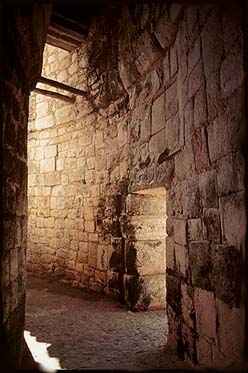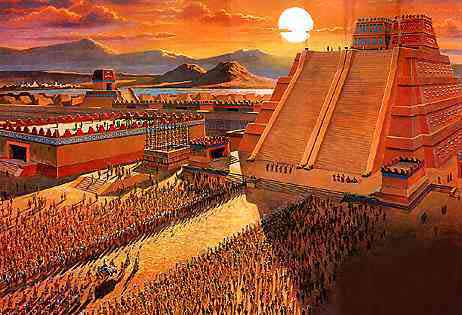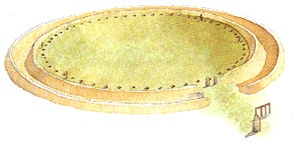Mesoamerica

Mayan Temple of the Sun
As with other ancient cultures, observatories, pyramids and temples were erected based on celestial alignments. Prior to the Maya rising to power circa 400 AD in Central America and Mexico, there is evidence that the Olmec people had already begun to use astronomical orientations to direct the layout of several ceremonial centers, with the Pyramids of the New World oriented to observing and predicting the motions of the Sun and Mon.
As with the Egyptians, we can deduce that Mayan astronomical endeavors, heavily relied upon the ritual and ceremonial worlds of the culture, however, here we have a wealth of evidence to substantiate such claims. Left behind are codices, or systems of hieroglyphic recordings of the Maya, and which include celestial sightings and how these sightings and predictions are woven into the entire cultural complex.
'The Dresden Codex' has perhaps proved the most fruitful in helping to recreate the ancient environment, and containing an elaborate calendar used to record the observations of Venus, which seems to be an object of utmost importance to them. Working with both a solar calendar and a ritual calendar, the ancient Maya imparted much meaning in the helical rising of Venus, which is made evident in the structure of several ceremonial centers throughout the area. Unlike the Megalithic and Egyptian complexes, scientific observation can be better deciphered here, because of the elaborate records left behind, and because of the fact that so many of the deductions the Maya made so closely resemble recent calculations of the same recorded cycles.

Mayan Temple of the Sun
As with other ancient cultures, observatories, pyramids and temples were erected based on celestial alignments. Prior to the Maya rising to power circa 400 AD in Central America and Mexico, there is evidence that the Olmec people had already begun to use astronomical orientations to direct the layout of several ceremonial centers, with the Pyramids of the New World oriented to observing and predicting the motions of the Sun and Mon.
As with the Egyptians, we can deduce that Mayan astronomical endeavors, heavily relied upon the ritual and ceremonial worlds of the culture, however, here we have a wealth of evidence to substantiate such claims. Left behind are codices, or systems of hieroglyphic recordings of the Maya, and which include celestial sightings and how these sightings and predictions are woven into the entire cultural complex.
'The Dresden Codex' has perhaps proved the most fruitful in helping to recreate the ancient environment, and containing an elaborate calendar used to record the observations of Venus, which seems to be an object of utmost importance to them. Working with both a solar calendar and a ritual calendar, the ancient Maya imparted much meaning in the helical rising of Venus, which is made evident in the structure of several ceremonial centers throughout the area. Unlike the Megalithic and Egyptian complexes, scientific observation can be better deciphered here, because of the elaborate records left behind, and because of the fact that so many of the deductions the Maya made so closely resemble recent calculations of the same recorded cycles.








 Stonehenge I (3100-2300 BCE)
Stonehenge I (3100-2300 BCE) 


 Cahokia was the most important center for the peoples known today as Mississippians. Their settlements ranged across what is now the Midwest, Eastern, and Southeastern United States. Cahokia maintained trade links with communities as far away as the Great Lakes to the north and the Gulf Coast to the south. Pottery and stone tools in the Cahokian style were found at the Silvernale site near Red Wing, Minnesota. At the high point of its development, Cahokia was the largest urban center north of the great Mesoamerican cities in Mexico. Although it was home to only about 1,000 people before ca. 1050, its population grew explosively after that date. Archaeologists estimate the city's population at between 8,000 and 40,000 at its peak, with more people living in outlying farming villages that supplied the main urban center. If the highest population estimates are correct, Cahokia was larger than any subsequent city in the United States until about 1800, when Philadelphia's population grew beyond 40,000.
Cahokia was the most important center for the peoples known today as Mississippians. Their settlements ranged across what is now the Midwest, Eastern, and Southeastern United States. Cahokia maintained trade links with communities as far away as the Great Lakes to the north and the Gulf Coast to the south. Pottery and stone tools in the Cahokian style were found at the Silvernale site near Red Wing, Minnesota. At the high point of its development, Cahokia was the largest urban center north of the great Mesoamerican cities in Mexico. Although it was home to only about 1,000 people before ca. 1050, its population grew explosively after that date. Archaeologists estimate the city's population at between 8,000 and 40,000 at its peak, with more people living in outlying farming villages that supplied the main urban center. If the highest population estimates are correct, Cahokia was larger than any subsequent city in the United States until about 1800, when Philadelphia's population grew beyond 40,000.


تعليق